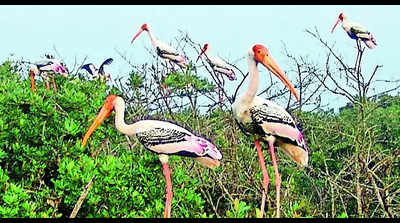Bird Numbers Rise By Over 6,200 In Bhitarkanika During Nesting Season | Bhubaneswar News


Kendrapada: Population of resident birds in Kendrapada district’s Bhitarkanika National Park went up by around 6,200, according to the results of the avian census released on Saturday.
The number of birds counted rose to 1,30,123 this time compared to 1,23,867 in 2023. Ten different bird species have built 27,282 nests on 1,300 trees during this monsoon, data revealed.Sources said monsoon marks the nesting period of birds at the park.
“We used the direct count method for the bird census. We monitored all water bodies and mangrove forest areas in Bhitarkanika from Sept 9 to 13. Around 30 people, including ornithologists, officials of wildlife organisations and three teams of wildlife activists, took part in the census work. Rise in the number of birds in Bhitarkanika is believed to be a good sign for conservation programmes in the state,” said Sudarshan Gopinath Yadav, divisional forest officer (DFO), Bhitarkanika.
Yadav further said that a large number of birds were found in Mathadia Laxmiprasaddia, Durgaprasaddia and Balidia mangrove forests during the nesting season. He said abundant fish in the river and creeks and distance from human habitation make the park a suitable breeding place for birds.
“Watching the birds make and mend nests, collect branches for building and repairing nests, lay, incubate and hatch eggs, feed fledglings, guard them against predators and cover them with outspread wings to protect them from the scorching sun and heavy downpour is a sight to behold,” added the DFO.
“In 1981, ornithologist Salim Ali visited Bhitarkanika and suggested the govt to declare it a ‘biosphere reserve’ and get it surveyed by scientific organisations. However, no action has been taken on the suggestion so far,” said environmentalist Hemant Rout.
We also published the following articles recently
Persistent rainfall has filled the Jayakwadi dam in Chhatrapati Sambhajinagar to nearly full capacity, leading the forest department to anticipate fewer migratory birds this season. High water levels and illegal wetland farming have reduced bird habitats. Major migratory species expected include Flamingos, Plovers, and Barn Swallows.
The bird flu scare has altered food preferences in Bhubaneswar, with a notable decline in chicken and egg consumption. Restaurants are adapting by serving more mutton, seafood, and native chicken. Poultry farmers face significant losses as chickens surpass their sale age, further strained by West Bengal’s ban on imports from Odisha.
A person in Missouri was hospitalized with bird flu without known exposure to infected animals, raising concerns about possible human-to-human transmission. This is the first such case in the current outbreak. The individual has recovered. Symptoms include high temperature and body pain. Preventive measures emphasize hand hygiene and avoiding contact with live birds.















